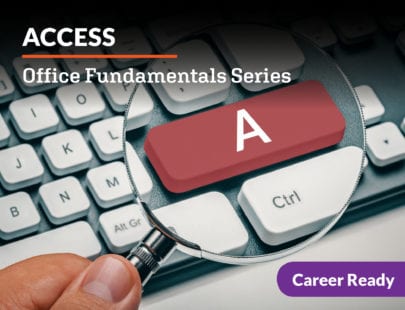
Excel: Office Fundamentals Series
Discover the real-world uses of Microsoft Excel and its impact on business, academic, and personal applications. Move from inserting and manipulating data, to working with tables, charts, graphs, and calculations. Content of this course will also be applicable to the Microsoft Office Suite certification exam.
Units at a Glance
Unit 1: Getting Started with Excel
Imagine a supercomputer—a huge, metallic box that completes millions of calculations instantaneously. Sounds impressive, right? What about software that completes millions of calculations and updates data in real time? Well, applications like that have existed for a long time. One of the best applications for recording, calculating, and working with data is Microsoft Excel. It plays an integral part in the business world, but it also has personal applications too. Whether you are running a major corporation with 1,000 or more employees or tracking how much money you have earned between your home allowance and your part-time wages, Excel can help you organize, manage, and budget so that you can make informed decisions when it comes to money.
What will you learn in this unit?
- Explain how Excel helps to manage information
- Download, create, and open Excel workbooks
- Enter and search for data in an Excel workbook
- Use Excel formatting tools
- Describe the uses of Excel for business and personal tasks
Unit 2: Customizing and Configuring
Being able to configure options and views is essential for making the most of Excel. So is being able to sort and filter data effectively. And once you’ve worked with your data, you’ll need to know how to print and save effectively, as it can be a little more complicated than other Office products. These fundamentals will add to the solid foundation that’s already been created and act as a springboard for getting the most out of Excel.
What will you learn in this unit?
- Configure and customize settings and toolbars
- Merge and align data in cells
- Change the display and views of worksheets
- Sort and filter data
- Save and print data from an Excel workbook
- Discuss how different work environments use Excel spreadsheets
Unit 3: A Range of Data
Excel can be deceptively simple—the real magic begins when you learn how to handle Excel’s basic editing and formatting tools and gain a solid understanding of when to use them. The next step in the process is to think creatively: What can you do with the data you have, and how can you do it? That’s precisely what learning Excel is all about—realizing the possibilities by using the available tools.
What will you learn in this unit?
- Import data from a variety of sources into Excel
- Define and reference named ranges
- Apply number formats to cells
- Use the SUM function to create a subtotal
Unit 4: Fun with Formulas and Functions
So far, many of the essentials you’ve learned have been about entering, deleting, or presenting data. Now it’s finally time to do something with this data and dive into some of the most versatile things Excel has to offer—functions and formulas. From simple addition to complex calculations using dozens of components and data points, the possibilities are almost endless.
What will you learn in this unit?
- Calculate and transform data by using common functions
- Differentiate between relative and absolute references
- Perform conditional operations using conditional functions
- Format text by using functions on strings
- Describe common uses of functions and formulas in business
Unit 5: Organizational Essentials: Charts and Data
Data visualization is a key aspect of presenting any sort of data in a business environment. Printing out a worksheet is technically possible but won’t be easy to understand for people who may not be as familiar with Excel as you are. Think of the potential audience: Who will be looking at your data, and what sort of tool can you use to help them? The simplest and often most effective answer is charts—they are a great visualization tool.
What will you learn in this unit?
- Identify the four main types of data and their best use
- Insert, update, and format a variety of charts
- Explain and demonstrate the use of pie charts
- Explain and demonstrate the use of line charts
- Explain and demonstrate the use of column charts
- Analyze data and decide what kind of visualization tool to use
Unit 6: Creating and Managing Tables
We often think of Excel spreadsheets as being one giant table. After all, there are rows and columns, just like a table. But it turns out that it’s a separate feature. You can turn a group of related data into a table to make tasks like sorting and filtering easy breezy. You can also create more advanced tables—known as PivotTables—to accomplish some high-level data analysis. Add in some style and design, and you’re well on your way to creating some truly impressive tables!
What will you learn in this unit?
- Create regular tables and PivotTables
- Sort and filter regular tables and PivotTables
- Apply subtotals to regular tables and PivotTables
- Use the Analyze Data feature to gain insights about data
Unit 7: Excel at Work
Being able to use Excel for general tasks and being able to use Excel in the workplace are two very different things. While mastering Excel is an important first step, eventually you will have to adapt to being able to use Excel under pressure, in collaboration with others, and in less-than-ideal conditions such as with limited resources or time. The skills for this are ones you’ll acquire over time, but it’s always a good idea to get a head start now!
What will you learn in this unit?
- Summarize the tasks related to using a shared spreadsheet in a business setting
- Use Excel to record, edit, and maintain data for a variety of business tasks
- Work with advanced PivotTables and PivotCharts
- Describe how Excel works with other Microsoft 365 products
- Explain the principles of data analysis
Unit 8: Pulling It All Together
The basics of Excel are neither simple nor easy to learn, yet you’ve been doing a great job of it so far—all you need to do now is put it all together to be comfortable with switching at a moment’s notice between the tools you’ve learned and identifying the appropriate tools for different situations. Remind yourself of the different tools you’ve learned about, and of the many creative ways in which they can be used, and you’ll be on your way to Excel mastery in no time!
What will you learn in this unit?
- Add alt text to graphics in Excel
- Prep an Excel spreadsheet for printing
- Share and collaborate on a workbook
- Properly prepare an Excel file for distribution and presentation in a business environment
Required Materials
Across entire Course
- Microsoft Office Excel 2019, or an Office 365 Subscription



